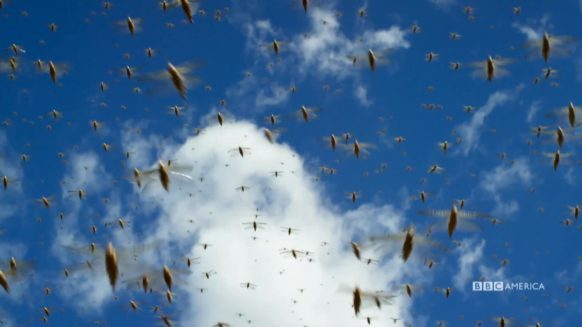By David Pierce for WIRED.

Plenty of people know that leopards wander the streets of Mumbai, but few people ever see them. The elusive cats hunt at night, shrouded by darkness and the din of the city. That made Gordon Buchanan’s job tricky.
The BBC sent Buchanan to Mumbai to film those cats for “Planet Earth II,” the epic nature documentary series that wraps up this weekend on BBC America. Filming wildlife isn’t like shooting a movie; the stars ignore your schedule and rarely appear when or where you want them to. You make your best guess about what might happen, set up your gear, and wait — sometimes for days. Buchanan did just that, erecting infrared “camera traps” throughout the leopard’s territory and checking them daily to discern its routine. Once he had a sense of the animal’s habits, Buchanan spent night after night hidden in a blind, panning the horizon with his camera, hoping to glimpse his quarry.
Buchanan favored a thermal rig designed for shooting in darkness. On a good night, he might spot the leopard — or, rather, its heat signature — through the foliage once or twice. On two occasions, he saw it hunting. Once, the big cat turned directly toward him, standing just feet away. It eventually wandered off. This kind of footage simply would not have been possible without cameras that did not exist a few years ago.
Heat-sensitive cameras, stabilized rigs, and drones provided an unprecedented view into the lives of the world’s weirdest and most wonderful creatures. Ten years ago, “Planet Earth” introduced viewers to the vibrant colors and pin-sharp resolution of high-definition filmmaking. The tagline promised the world “as you’ve never seen it before.” This time around, says Chadden Hunter, who directed and produced an episode about grasslands, the tagline could be more like: nature as you’ve never experienced it before.
Getting the band back together
The BBC spent five years making “Planet Earth” before it aired in 2006, and gave no thought to a sequel at the time. “When we make a landmark [show], we try to say, ‘This is the last word on the subject,’” says Mike Gunton, creative director for the BBC’s natural history unit. In time, though, the team saw new technology create new ways of telling a story.
The original 11-part series made heavy use of a shot you could call the god’s-eye view—a sweeping overheard aerial filmed from a helicopter. “There’s something about using helicopters that gave a majesty to it,” Gunton says. With the new series, everything is tighter, smaller, more intense. You see things from the animals’ perspective. “It demands proximity,” Gunton says, “it demands you have the camera in the world of the animal.” He hates the word immersion, which has been rendered all but meaningless by overuse, but says that is exactly the quality he wanted here. “In the old days,” Gunton says, “you became the camera, because the camera’s in your position. Now the camera becomes you. You’re in that world, you’re sensing and seeing.”
You see a lot of new filmmaking technology in “Planet Earth II,” but no single innovation made it possible. Instead, the documentary series reflects a decade of steady improvements that have led to smaller, lighter, better cameras, particularly those that excel in poor lighting. The crew tended to use cameras available to anyone with the money. They favored the Red Epic Dragon because it shoots 6K footage, works in even the worst conditions, and weighs just 5 pounds without a lens. The Sony A7S II was a favorite in low-light situations, and the crews also used Go Pro-style cameras, consumer drones, and more.
New filmmaking techniques also infuse “Planet Earth II.” Ed Charles, who directed the episode “Deserts,” relied heavily on time-lapse photography to reveal the power of desert storms and the explosion of life and color that accompanies the spring bloom. The “Jungles” episode features John Brown’s work using a high-speed camera to film the elusive glass frog, a Costa Rican animal the size of your fingernail. The frog’s fight to save its broad from a swarm of wasps occurred so quickly that Brown didn’t know exactly what he’d filmed until he played it back later. High frame-rate cameras slow the action down enough to let you follow along.
Capturing amazing footage doesn’t count for much if it’s blurry, which makes stabilizer rigs like the DJI Ronin and Freefly Movi Pro essential. Put nearly any camera in the cradle, turn on the stabilizer, and you can run alongside a monkey and capture pin-sharp, rock-steady footage. Viewers literally follow along in the animal’s footsteps. Until recently, documentaries like“Planet Earth” relied on tripods, which limit filmmakers to panning shots. Gadgets like the Ronin and improvements stabilization processing in post-production let cameras fun and leap and fly through the world. And that is what makes “Planet Earth II” so impressive: It makes you feel like you are among the animals in a way you’ve never felt before.

One of Planet Earth II’s grossest and coolest moments features a billion-strong plague of locusts.
The portable rigs let director Fredi Devas film a scene at the beginning of the “Cities” episode that feels like a chase scene in a summer blockbuster. Huge langur monkeys leap from rooftop to rooftop as they wage aerial battles over the Indian city of Jodhpur. The langurs, inured to the bustle of urban living, ignored the cameras. Cameras fitted with ultra-wide angle lenses mounted on Movis and Ronins allowed the crew to film the creatures from just inches away. “They jump between rooftops,” Devas says, “and you have to go down five flights of steps, and then run along, and knock on someone’s door, and say, ‘Please please please, we think the langurs have moved to your rooftop.’” Lighter cameras and all, these shoots are still a workout. Maybe one day drones will help that.
Hurry up and wait
As a general rule, it takes about a week to film one minute of wildlife footage. The producer and crew dedicate a significant chunk of that time letting animals grow accustomed to the presence of a camera: they might erect a camera in the animal’s territory and leave it there for several days. Or they might turn on a drone, but not fly it, letting animals get used to the whirring of the propellors. Generally speaking, once the animal decides the camera is neither predator nor prey, they leave it alone.
Some animals simply don’t fear humans, because they’ve never known they should. But others want nothing to do with Homo sapiens. The BBC filmmakers spent a lot of time tucked away in makeshift blinds and hides. “It’ll be two people on a shoot,” Charles says. “Every morning you both walk down to the hide. The cameraman gets in, and then the other person walks away.” The idea is for the animals to see people coming and going, but not keep track of everyone. In other instances, crews might control a camera remotely, or simply leave it running and hope for the best.
At the beginning of production, the team spent months researching their territories. They identified possible characters, tried to plan shoots, and sketched out the show. But this is wildlife, so you work on Mother Nature’s timeline. Luck plays a role, which means being in the right place at the right time, or patient enough to wait. And wait. And wait some more. Even if the mosquitoes are driving you nuts.
Of course, luck doesn’t count for much if you don’t have the gear to capture a leopard in a dark alley, a tiny frog fighting a swarm of wasps, or monkeys waging an aerial battle. None of this was possible a decade ago, which has Gunton’s team wondering what might be possible a decade from now. They’re already thinking about “Planet Earth 3.”
More from WIRED:

